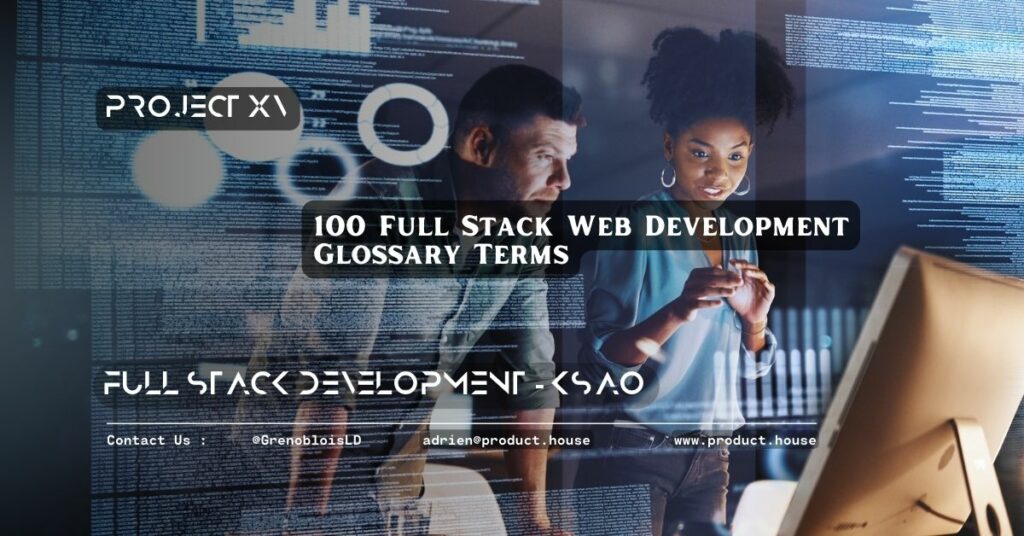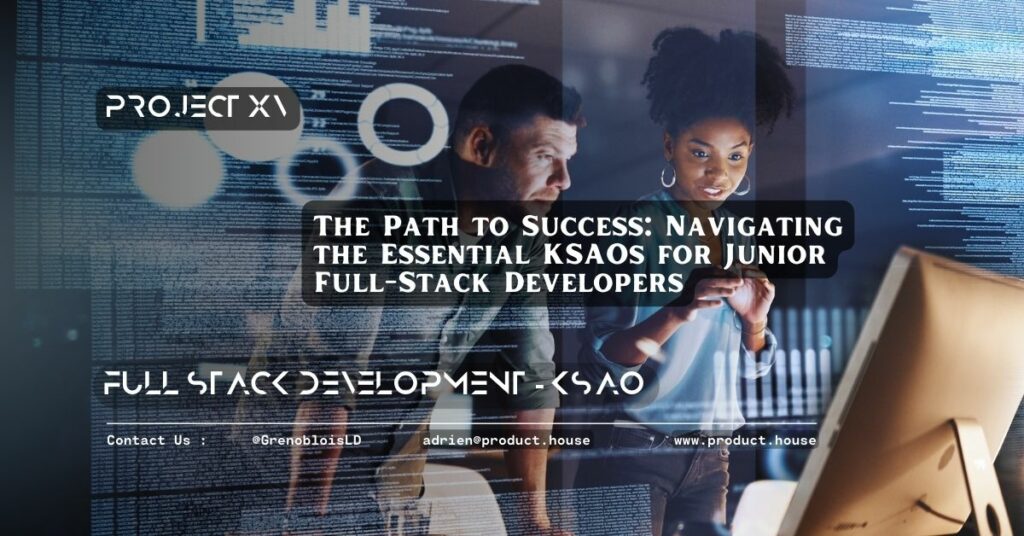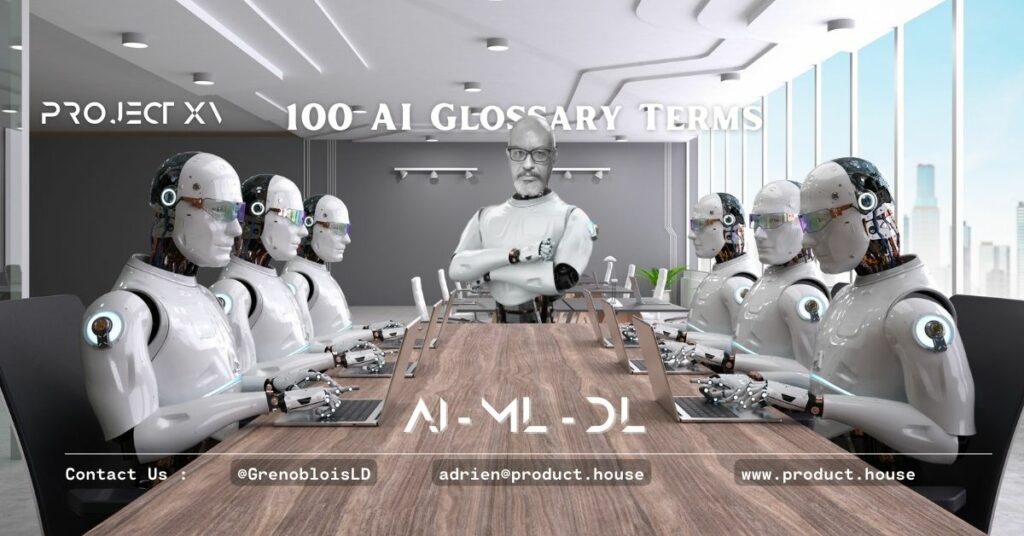100 Full Stack Web Development Glossary Terms

| # | Term | Definition |
|---|---|---|
| 1 | AJAX | Asynchronous JavaScript and XML; a technique for creating fast and dynamic web pages |
| 2 | API | Application Programming Interface; a set of protocols and tools for building software applications |
| 3 | Back-end | The part of a website or application that is responsible for handling data and server-side logic |
| 4 | Bootstrap | A front-end web development framework for creating responsive and mobile-first websites |
| 5 | CDN | Content Delivery Network; a network of servers that deliver web content to users based on their geographic location |
| 6 | CMS | Content Management System; a software application for managing the creation and modification of digital content |
| 7 | CRUD | Create, Read, Update, and Delete; a set of basic operations used in database management systems |
| 8 | CSS | Cascading Style Sheets; a language used for describing the presentation of a document written in HTML or XML |
| 9 | DevOps | Development and Operations; a set of practices for integrating software development and IT operations |
| 10 | DOM | Document Object Model; a programming interface for HTML and XML documents that represents the page so that programs can change the document structure |
| 11 | Front-end | The part of a website or application that the user interacts with, typically created using HTML, CSS, and JavaScript |
| 12 | Git | A distributed version control system for tracking changes in source code during software development |
| 13 | HTML | Hypertext Markup Language; a markup language used for creating web pages and other information viewable in a web browser |
| 14 | HTTP | Hypertext Transfer Protocol; an application protocol for transmitting data over the internet |
| 15 | IDE | Integrated Development Environment; a software application for building and debugging software |
| 16 | JavaScript | A programming language used to create interactive effects within web browsers |
| 17 | jQuery | A fast, small, and feature-rich JavaScript library that simplifies HTML document traversing, event handling, and animating |
| 18 | JSON | JavaScript Object Notation; a lightweight data interchange format that is easy for humans to read and write, and easy for machines to parse |
| 19 | MVC | Model-View-Controller; a design pattern for software architecture that separates an application into three interconnected components |
| 20 | Node.js | An open-source, cross-platform, back-end JavaScript runtime environment that runs on the V8 engine and executes JavaScript code outside a web browser |
| 21 | NPM | Node Package Manager; a package manager for the JavaScript programming language |
| 22 | ORM | Object-Relational Mapping; a programming technique for converting data between incompatible type systems in object-oriented programming languages |
| 23 | RESTful API | Representational State Transfer; a set of architectural principles for creating web services |
| 24 | Responsive design | A design approach that allows web pages to adjust their layout and content to fit different screen sizes and resolutions |
| 25 | SaaS | Software as a Service; a software licensing and delivery model in which software is provided over the internet |
| # | Term | Definition |
|---|---|---|
| 26 | Framework | A pre-made software environment that helps developers create applications more quickly and easily by providing a structure and set of tools to work with. |
| 27 | Front End | The part of a web application that users interact with directly, typically consisting of the interface, design, and user experience. |
| 28 | Full Stack | Refers to the entire range of technologies and skills necessary for building and running a web application, including both front-end and back-end development. |
| 29 | Git | A distributed version control system used for tracking changes in source code during software development. |
| 30 | GitHub | A web-based platform for version control and collaboration, primarily used for code sharing and open-source development. |
| 31 | HTML | Hypertext Markup Language, a standard markup language used for creating web pages and other online documents. |
| 32 | HTTP | Hypertext Transfer Protocol, the primary protocol used for transferring data on the web. |
| 33 | IDE | Integrated Development Environment, a software application that provides comprehensive tools and features for coding, debugging, and testing. |
| 34 | JavaScript | A high-level programming language used primarily for creating interactive web pages and other client-side applications. |
| 35 | JSON | JavaScript Object Notation, a lightweight data interchange format that is easy for humans to read and write, and easy for machines to parse and generate. |
| 36 | MVC | Model-View-Controller, a software architectural pattern that separates an application into three interconnected components: the model (data), the view (user interface), and the controller (logic). |
| 37 | MySQL | An open-source relational database management system that is widely used in web applications for storing and retrieving data. |
| 38 | Node.js | An open-source server-side runtime environment that allows developers to run JavaScript on the server. |
| 39 | NPM | Node Package Manager, a package manager for the Node.js environment that makes it easy to install and manage dependencies. |
| 40 | Object-Oriented Programming (OOP) | A programming paradigm that uses objects to represent data and methods to manipulate that data, with an emphasis on encapsulation, inheritance, and polymorphism. |
| 41 | PHP | A popular server-side scripting language used for web development, particularly in creating dynamic web pages. |
| 42 | REST | Representational State Transfer, a software architectural style that provides a standard for creating web services using HTTP methods such as GET, POST, PUT, and DELETE. |
| 43 | Ruby on Rails | A web application framework written in the Ruby programming language that emphasizes convention over configuration and follows the Model-View-Controller (MVC) architectural pattern. |
| 44 | SASS | Syntactically Awesome Style Sheets, a CSS preprocessor that extends the functionality of CSS and provides tools for creating more efficient and maintainable stylesheets. |
| 45 | SEO | Search Engine Optimization, the practice of optimizing a website’s content and structure to improve its visibility and ranking in search engine results pages. |
| 46 | Server | A computer program that provides services to other computer programs in the same or a different computer, typically over a network. |
| 47 | SQL | Structured Query Language, a domain-specific language used for managing and manipulating relational databases. |
| 48 | SSL | Secure Sockets Layer, a security protocol that provides encrypted communication between web servers and clients, primarily used for secure transactions and sensitive data. |
| 49 | TDD | Test-driven development is a development methodology in which tests are written before the code is written. This approach ensures that the code meets the requirements and is error-free. |
| # | Term | Definition |
|---|---|---|
| 50 | Git | A version control system for tracking changes in source code during software development. |
| 51 | Handlebars.js | A JavaScript templating engine that provides a semantic syntax for rendering templates in web applications. |
| 52 | Heroku | A cloud platform that allows developers to build, run, and operate applications in various programming languages. |
| 53 | HTTP | Hypertext Transfer Protocol is an application protocol used for transmitting data over the internet. |
| 54 | JavaScript | A high-level, interpreted programming language used to create dynamic web pages and web applications. |
| 55 | jQuery | A fast, small, and feature-rich JavaScript library used to simplify HTML document traversal and manipulation. |
| 56 | JSON | JavaScript Object Notation is a lightweight data interchange format that is easy for humans to read and write. |
| 57 | JSX | A syntax extension for JavaScript used in React to describe what the user interface should look like. |
| 58 | LAMP | A web development stack that stands for Linux, Apache, MySQL, and PHP/Perl/Python, used for creating dynamic web applications. |
| 59 | Laravel | A free, open-source PHP web application framework used for web development. |
| 60 | LESS | A dynamic stylesheet language that extends the capability of CSS. |
| 61 | MVC | Model-View-Controller is a software design pattern used in developing user interfaces. |
| 62 | MySQL | An open-source relational database management system used to manage and store data in web applications. |
| 63 | Node.js | An open-source, cross-platform JavaScript runtime environment used to run JavaScript code outside of a web browser. |
| 64 | npm | A package manager for the Node.js platform used to manage dependencies in a project. |
| 65 | PHP | A popular server-side scripting language used to create dynamic web pages. |
| 66 | PostgreSQL | A powerful, open-source relational database management system used for storing data in web applications. |
| 67 | Python | A high-level, interpreted programming language used for web development, data analysis, and artificial intelligence. |
| 68 | React.js | A JavaScript library used for building user interfaces or UI components in web applications. |
| 69 | REST | Representational State Transfer is a software architectural style used for creating web services. |
| 70 | Ruby on Rails | A popular, open-source web application framework written in the Ruby programming language. |
| 71 | SaaS | Software as a Service is a software delivery model where applications are hosted by a third-party provider. |
| 72 | Scrum | An agile framework for managing and completing complex projects. |
| 73 | SQL | Structured Query Language is a programming language used to manage and manipulate relational databases. |
| 74 | TypeScript | A typed superset of JavaScript that compiles to plain JavaScript. |
| # | Term | Definition |
|---|---|---|
| 76 | Object-Oriented Programming (OOP) | A programming paradigm that uses objects to represent and manipulate data. Objects contain both data and functions that operate on that data. OOP is a popular programming approach in Full Stack Web Development. |
| 77 | Package Manager | A tool that automates the process of installing, updating, configuring, and removing software packages. Package managers are commonly used in Full Stack Web Development to manage dependencies and libraries. Examples include npm for Node.js and pip for Python. |
| 78 | PHP | A server-side scripting language that is widely used in Full Stack Web Development. PHP is particularly well-suited for building dynamic web applications and is often used in conjunction with a database system like MySQL. |
| 79 | Plugin | A software component that adds a specific feature or functionality to an existing software application. Plugins are commonly used in Full Stack Web Development to extend the capabilities of content management systems, web browsers, and other software tools. |
| 80 | PostgreSQL | An open-source relational database management system that is widely used in Full Stack Web Development. PostgreSQL is known for its reliability, scalability, and robustness, and is particularly well-suited for complex database-driven applications. |
| 81 | React | A popular JavaScript library for building user interfaces. React is often used in Full Stack Web Development to create dynamic, interactive web applications that update in real-time without requiring a page reload. |
| 82 | REST | An architectural style for building web services that uses HTTP requests to access and manipulate data. REST is a common approach in Full Stack Web Development for building web APIs that can be easily consumed by different clients and devices. |
| 83 | Responsive Web Design | A design approach that allows web pages to adapt to different screen sizes and device types. Responsive web design is a key consideration in Full Stack Web Development, as it ensures that web pages are accessible and functional across a wide range of devices. |
| 84 | Ruby on Rails | An open-source web application framework that is written in the Ruby programming language. Ruby on Rails is widely used in Full Stack Web Development due to its simplicity, productivity, and focus on convention over configuration. |
| 85 | Sass | A preprocessor scripting language that is used to generate CSS stylesheets. Sass is often used in Full Stack Web Development to simplify the process of writing and maintaining complex CSS stylesheets. |
| 86 | SEO | Search Engine Optimization (SEO) is the process of optimizing a website to rank higher in search engine results pages. SEO is an important consideration in Full Stack Web Development, as it helps to increase the visibility and accessibility of a website. |
| 87 | Server | A computer or software program that provides functionality or services to other programs or devices. In Full Stack Web Development, the term “server” typically refers to the hardware or software that provides web hosting, database management, or other back-end functionality. |
| 88 | Serverless Computing | A cloud computing model where the cloud provider manages the infrastructure and automatically allocates resources as needed, without requiring the user to manage servers or capacity. Serverless computing is increasingly popular in Full Stack Web Development due to its scalability, cost-effectiveness, and flexibility. |
| 89 | Source Code | The human-readable instructions that make up a computer program. In Full Stack Web Development, source code is typically written in a high-level programming language and then compiled or interpreted into machine code that can be executed by a computer. |
| 90 | SQL | Structured Query Language (SQL) is a programming language that is used to manage relational databases. |
| # | Term | Definition |
|---|---|---|
| 91 | SSL | SSL (Secure Sockets Layer) is a protocol that provides secure communications on the internet. It is commonly used to protect sensitive data, such as login credentials and financial information. |
| 92 | SQL | SQL (Structured Query Language) is a programming language used for managing and manipulating data in relational databases. It is used to insert, update, and retrieve data from a database. |
| 93 | Stack | A stack is a collection of technologies used to build a web application. It typically includes a front-end technology, a back-end technology, and a database. |
| 94 | TCP/IP | TCP/IP (Transmission Control Protocol/Internet Protocol) is a set of protocols used for transmitting data over the internet. It is responsible for breaking data into packets, routing the packets, and reassembling the data at the destination. |
| 95 | Test-driven development | Test-driven development is a development methodology in which tests are written before the code is written. This approach ensures that the code meets the requirements and is error-free. |
| 96 | UI/UX | UI (User Interface) and UX (User Experience) are two closely related design disciplines. UI refers to the visual design of a product, while UX refers to the overall experience of using the product. |
| 97 | URL | A URL (Uniform Resource Locator) is the address of a resource on the internet. It typically includes the protocol (e.g., http or https), the domain name, and the path to the resource. |
| 98 | Version control | Version control is a system for managing changes to source code. It allows developers to track changes, collaborate with others, and revert to previous versions if necessary. |
| 99 | Web server | A web server is a computer program that is responsible for serving web pages to clients. It receives requests from clients, retrieves the requested resources, and sends them back to the clients. |
| 100 | XML | XML (Extensible Markup Language) is a markup language used for storing and transporting data. It is designed to be both human-readable and machine-readable, making it a popular choice for exchanging data between different systems. |





